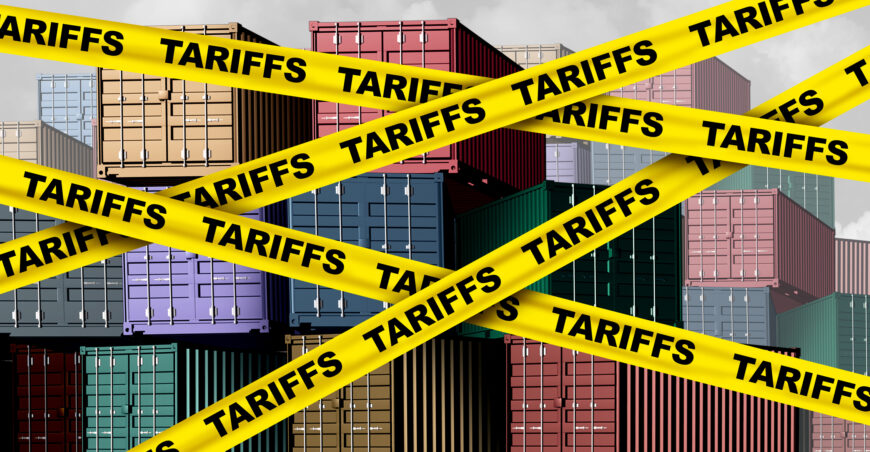Global trade tensions between the U.S. and Canada have been intensifying, with tariffs once again making headlines. The latest round of trade disputes has triggered retaliatory tariffs from Canada, impacting key industries such as steel, lumber, and manufactured goods. While most coverage focuses on the direct impact on businesses and consumers, the ripple effects extend further, reaching deep into the commercial real estate sector in the U.S.
For investors, developers, and tenants, these trade policies are more than just political maneuvering. They have real financial implications, affecting everything from construction costs to lease negotiations and investment strategies. Let’s break down how trade wars and tariffs are shaping U.S. commercial real estate.
Understanding the Current Trade War with Canada
The U.S.-Canada trade relationship has long been one of the most significant in the world. Canada is the largest trading partner of the U.S., with billions of dollars in goods and services exchanged daily. However, recent disputes over steel, aluminum, and timber along with other industries have fueled a fresh wave of tariffs and countermeasures.
In response to U.S. trade policies, Canada has imposed tariffs on American-made goods, particularly affecting industries reliant on raw materials. Lumber, steel, and aluminum – critical components in the construction and real estate industries are among the most heavily impacted sectors. As these materials become more expensive due to import duties, their costs trickle down through the entire commercial real estate ecosystem.
The Impact on U.S. Commercial Real Estate
1. Higher Construction Costs
One of the most immediate and tangible effects of tariffs is rising construction costs. A lot of commercial real estate projects depend on materials imported from Canada, including softwood lumber for framing and steel for structural components. With tariffs in place, developers are seeing their material costs surge, leading to:
- Increased project costs – Higher costs for raw materials make it more expensive to develop office buildings, retail centers, and industrial spaces.
- Delayed developments – Some developers are putting projects on hold until they can better assess long-term costs.
- Smaller profit margins – Investors and developers are finding it more challenging to maintain profitability without increasing rents or making cost-cutting design changes.
2. Rising Lease Rates for Tenants
When construction costs rise, so do lease rates. Property owners and landlords pass these added expenses on to tenants, particularly in new developments or properties undergoing renovations. This is especially concerning for small businesses that already struggle with high occupancy costs.
In markets where supply is already constrained, such as industrial and medical office spaces, rent hikes could further drive-up costs for tenants who depend on affordable lease rates to remain competitive.
3. Slowdown in Industrial Expansion
The industrial real estate sector has been booming, largely driven by e-commerce growth and increased demand for logistics hubs. However, tariffs on steel and aluminum have made it more expensive to build warehouses and distribution centers.
Major players like Amazon and Walmart, who rely on large-scale logistics infrastructure, may rethink expansion strategies or shift development to regions where material costs are lower. Additionally, manufacturers dependent on Canadian imports may reconsider their U.S. presence, opting to move operations elsewhere to avoid high tariffs.
4. Impact on Cross-Border Investment
Canada is a significant investor in U.S. commercial real estate. Canadian firms, pension funds, and private investors have historically been among the largest foreign buyers of American office buildings, retail centers, and industrial properties. However, with increased trade tensions, Canadian investors may hesitate to commit capital to U.S. assets, fearing economic instability.
Conversely, American firms looking to invest in Canadian commercial properties may face higher barriers due to trade uncertainties, limiting cross-border investment opportunities.
5. Shifts in Supply Chains and Tenant Demand
As tariffs reshape supply chains, some businesses may choose to relocate closer to sources of raw materials or manufacturing hubs. This shift could create pockets of new demand in certain regions while leaving other markets with excess inventory.
For example, if Canadian companies reduce their U.S. imports, distribution centers and logistics properties near major border crossings could see lower demand, impacting industrial real estate in areas like Michigan, New York, and Minnesota.
Who Stands to Gain?
Not all aspects of the trade war spell doom for commercial real estate. Some regions and sectors could benefit:
- Domestic manufacturers – U.S. manufacturers that produce steel, aluminum, and lumber could see an uptick in demand, leading to increased industrial leasing in key manufacturing hubs.
- Secondary markets – As construction costs surge in primary markets, developers may shift focus to secondary cities where land and labor are more affordable, boosting CRE activity in those areas.
- Alternative materials – Rising costs of traditional building materials could accelerate innovation in alternative construction methods, such as modular building and 3D-printed structures, which may reduce long-term costs.
What’s Next for Commercial Real Estate?
The ongoing trade tensions between the U.S. and Canada are unlikely to resolve overnight. While both governments continue to negotiate trade agreements, commercial real estate professionals must prepare for continued uncertainty.
Strategies for Navigating the Impact:
- Diversify Suppliers – Developers and contractors should explore alternative material sources to mitigate tariff-related cost increases.
- Adjust Investment Strategies – Investors should consider regions and asset types less impacted by trade policies, such as stabilized assets with minimal renovation needs.
- Renegotiate Lease Terms – Tenants facing rent hikes due to higher construction costs should explore long-term lease options to lock in rates before further increases.
- Monitor Policy Changes – Staying informed about trade policies and potential tariff rollbacks can help CRE professionals anticipate market shifts.
The U.S.-Canada trade war and its resulting tariffs have created a complex landscape for commercial real estate. While challenges such as rising construction costs and increased lease rates are evident, strategic investors and developers can find ways to navigate the volatility.
As trade negotiations evolve, staying informed and adaptable is key to making sound investment decisions. The ICRE Investment Team is here to help you analyze market trends, identify strategic opportunities, and develop tailored solutions that align with your investment goals. Whether you’re looking to diversify your portfolio, adjust your investment strategy, or navigate tenant negotiations, our expertise ensures you stay ahead of the curve and position yourself for long-term success. Reach out to us today to make informed, strategic real estate decisions.
















